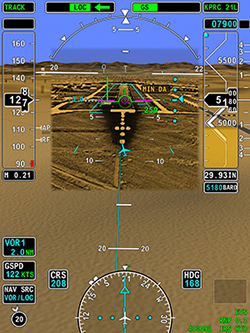Honeywell's SmartView Moves Ahead
Picture-in-picture PFDs
 For the past 10 years Honeywell has been developing what it hopes will be the next big step in avionics enhancements. It’s a presentation called SmartView, and it puts a combination of enhanced vision system (EVS, or infrared imagery) and synthetic vision system (SVS) imagery on the company’s Primus Epic-based primary flight displays (PFDs). The result is a “picture-in-picture” rendition of the environment ahead, with the EVS view centrally located on the PFD, and superimposed on synthetic terrain representations. Essential flight information—airspeed, altitude, navigation, autopilot status, plus thrust management cues—is provided at all the conventional locations on the PFD.
For the past 10 years Honeywell has been developing what it hopes will be the next big step in avionics enhancements. It’s a presentation called SmartView, and it puts a combination of enhanced vision system (EVS, or infrared imagery) and synthetic vision system (SVS) imagery on the company’s Primus Epic-based primary flight displays (PFDs). The result is a “picture-in-picture” rendition of the environment ahead, with the EVS view centrally located on the PFD, and superimposed on synthetic terrain representations. Essential flight information—airspeed, altitude, navigation, autopilot status, plus thrust management cues—is provided at all the conventional locations on the PFD.
The whole idea is to do away with the traditional head-up display (HUD) in favor of what Honeywell says is a more natural view of the terrain ahead. Although SmartView is a head-down display, Honeywell says that in the critical moments spent transitioning from instrument to visual flight during low-visibility approaches and landings, SmartView provides more intuitive information that meets or exceeds the quality provided by HUDs.
In addition to its greenish, monochromatic views and limited visual cues, Honeywell points to the HUD systems’ heading-centric forward view. In other words, symbols representing the airplane’s heading are centered in the HUD’s flip-down screen. SmartView reflects Honeywell’s belief that flight-path/track information takes precedence. For this reason, Honeywell favors a green flight-path marker symbol in the center of
its PFDs. It’s more important to know where the airplane is going, goes the logic, than knowing simply where the airplane’s nose is pointing. This takes on central importance when flying a HUD on low-visibility approaches in strong crosswinds; large heading corrections can put the landing runway’s symbology off the edge of the HUD.
SmartView’s algorithms essentially “move the world,” according to Honeywell, and put heading, flight path, and track symbology front and center. The result is a view down final that’s vastly superior to those generated by a HUD, as seen during test flights in Honeywell’s SmartView-equipped Gulfstream 450. The EVS portion of the PFD provides a colorized, decluttered real-time view of the entire runway environment, and as you approach the runway threshold the EVS image widens, yet includes synthetic vision components in the display.
October 2011
Turbine Pilot Contents
- Turbine Intro: Powering into the future: Special section for the turbine inclined.
- The NeXT Beechjet: New power, panel, and pylon mods for the “old” Beechjet
- Routes Less Traveled: HondaJet sprints toward 2012 certification schedule
- Flying the Jumbo, Jumbo: Taking on the A380
- Honeywell’s SmartView Moves Ahead: Merging infrared with synthetic vision
During AOPA Pilot’s test flights, we were instructed to fly SmartView down to 100 feet agl to simulate a Category II approach, then look up to visually acquire the approach lights and the runway in preparation for landing. The transition was nearly seamless, with none of the “surprise, here’s the runway” last-second transitioning that can be common in HUD approaches in low visibility. And with colorized terrain, clouds, range markers, and runway-remaining markers visible in both the EVS and SVS views, situational awareness gets a big boost.
Honeywell is nearly finished with its pilot performance assessments of SmartView. Developing a formal program for FAA flight tests is next. Honeywell was vague about a certification date, saying only that the very ambitious and well-documented program is on track.
Email the author at [email protected].


